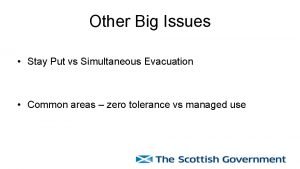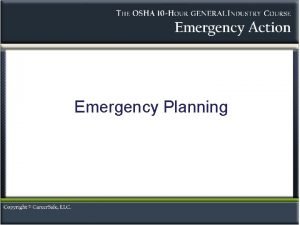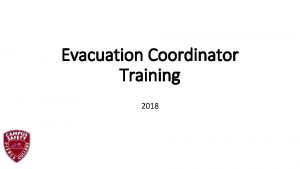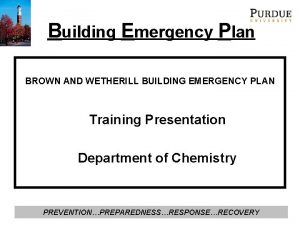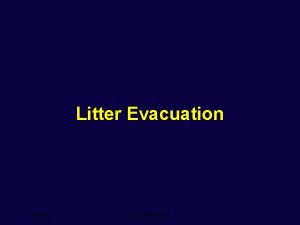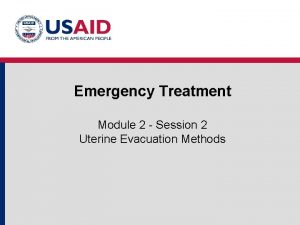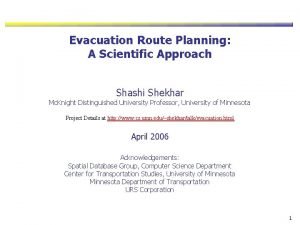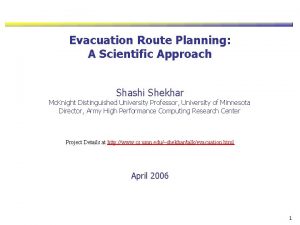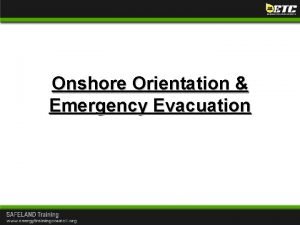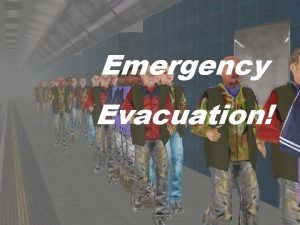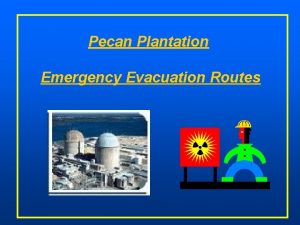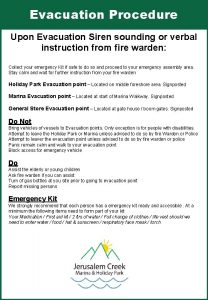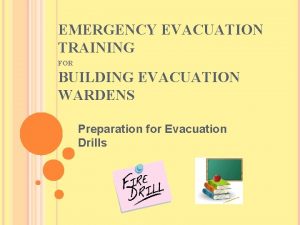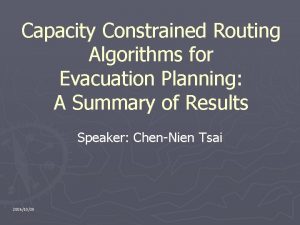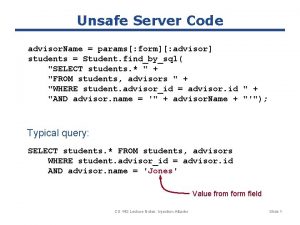Evacuation Planning Algorithms Qingsong Lu Advisor Prof Shashi























- Slides: 23

Evacuation Planning Algorithms Qingsong Lu Advisor: Prof. Shashi Shekhar August 9, 2002 1

Outline n n n n Motivation What can GIS do Problem statement Related works A simple example Our approach Algorithms 2

Motivation Why we need evacuation planning? Civil defense under emergency and hazard situations: Terrorist attacks (September 11 th ) Toxic agents released in a building, e. g. a stadium Tornado or hurricane approaching urban districts Urban Warfare Route planning for soldiers to a target in face of obstacles Crowd dispersion or evacuation 3

What can GIS do? - ESRI White Paper “GIS plays a significant role in each milestone of the emergency planning process. ” 4

What can GIS do? - ESRI White Paper Preparedness GIS can provide answers to questions: • What evacuation routes should be selected if a toxic cloud or plume is accidentally or intentionally released from a known plant, storage facility, or terrorist device based on different wind patterns? • What are alternative routes? • How will people be notified? • Will the road networks handle the traffic? 5

What can GIS do? - A Fortune Article ( Screenshot from www. fortune. com ) 6

What can GIS do? - A Fortune Article Base Map Chemical Plume Modeling - Where is source of the plume? - Where will plume go? - County map showing land, water, bridges, and roads, - Map showing plume dispersion in the next few hours, - Source: Government information system - Source: Plume modeling and prediction tools Weather Info - What is the current weather? Evacuation Analysis - How to evacuate? - Radar image of current weather, - Map of major highways, - Source: National Weather Services - Source: State DOT Demographic Info - Where are the people? - Map of population density overlaid on the county map - Source: U. S. Census Bureau database - Issue evacuation instruction to affected people Question not answered: How to produce evacuation plan ? Evacuation planning ( Images from www. fortune. com ) 7

Lessons We Learned Hurricane Andrew Florida and Louisiana, 1992 n No effective evacuation planning n Traffic congestions on all highways n Great confusions and chaos ( National Weather Services) "We packed up Morgan City residents to evacuate in the a. m. on the day that Andrew hit coastal Louisiana, but in early afternoon the majority came back home. The traffic was so bad that they couldn't get through Lafayette. " - Morgan City, Louisiana Mayor Tim Mott ( http: //i 49 south. com/hurricane. htm ) ( www. washingtonpost. com) 8

Lessons We Learned “Black Hawk Down” Mogadishu, Somalia October 3, 1993 n Soldiers trapped by roadblocks n No alternate evacuation routes Rescue team got lost in alleys having no planned route to crash site n 18 Army Rangers and elite Delta Force soldiers killed, 73 wounded. n ( Mark Bowden, Black Hawk Down: A Story of Modern War ) 9

Problem Statement Given n Transportation network (e. g. building floor map, city roadmap) with capacity constraints Initial number of people to be evacuated and their initial location Evacuation destinations Output n Scheduling of people to be evacuated and the routes to be taken Objective n n Minimize total time needed for evacuation Minimize computational overhead Constraints n Capacity constraints: evacuation plan meets capacity of the network 10

Related Works Simple network flow algorithms n Exponential running time n Implementation: EVACNET n n n University of Florida and National Fire Research Center, 1980’s Produce optimal plan High computational overhead Integer programming algorithms n Hoppe and Tardos (1995) n The only known polynomial algorithm n Produce integer optimal solution n Not practical to implement: “ …Their algorithm repeatedly minimizes submodular functions using the ellipsoid method, and is therefore not at all practical. ” - L. Fleisher 11

Related Works Heuristic approach: n EXIT 89(National Fire Protection Association) n n Only compute shortest distance routes from source to staircase for each floor, may not be shortest route to destination Do not consider capacity constraints Only apply to high-rise building evacuation Better heuristic algorithms needed 12

A Simple Example – Building Layout Two-story building: - Two Staircases - Two exits on first floor 13

A Simple Example – Node and Edge Definition Nodes: Edges: 14

A Simple Example • Each node has: Max. cap: 50 Init. Occup: 10 Node capacity ( max. number of people the node can hold) Max cap: 50 Init. Occup: 5 Initial occupancy ( number of people at the node ) • Each edge has: Edge capacity ( max. number of people can travel through this edge simultaneously ) Travel time ( how long it takes to travel through this edge) Capacity=6 Travel time=3 Max. cap: 65 Init. Occup: 15 15

Node-Edge Graph Model Node N 1, 50 (10) Node ID, Max Capacity (Initial Occupancy) (7, 1) N 4, 8 (3, 3) First Floor EXIT #1 N 13 (14, 4) N 9, 25 N 5, 6 (3, 4) Edge (Max Capacity, Travel time) Exit N 2, 50 (5) N 6, 10 (5, 5) (3, 3) (7, 1) (5, 4) Second Floor N 3, 30 N 7, 8 (6, 4) Node ID (2, 5) (6, 4) (8, 1) N 10, 30 (6, 3) N 8, 65 (15) (3, 3) N 11, 8 (3, 1) (6, 4) N 12, 18 (3, 3) N 14 EXIT #2 16

Evacuation Plan – Table 1 Number of people move though each edge starting from each time interval N 8 N 10 N 1 -N 3 N 2 -N 3 6 7 5 6 3 N 4 -N 6 N 5 -N 7 N 6 N 10 N 7 N 11 3 2 5 3 2 6 3 2 8 3 2 9 3 2 10 3 2 0 1 N 8 N 11 3 N 11 N 14 N 10 N 13 2 3 3 4 6 N 3 -N 4 N 3 -N 5 3 2 3 2 6 7 11 12 13 2 3 14 2 3 15 2 3 - Global based, assignment of flow to edges, - Does not show routes 17

Evacuation Plan – Table 2 Group of People Start time Route Exit time No. of people 6 0 N 8 -N 10 -N 13 4 ID A Origin N 8 B N 8 6 1 N 8 -N 10 -N 13 5 C N 8 3 0 N 8 -N 11 -N 14 4 D N 1 3 0 N 1 -N 3 -N 4 -N 6 -N 10 -N 13 14 E N 1 3 1 N 1 -N 3 -N 4 -N 6 -N 10 -N 13 15 F N 1 3 2 N 1 -N 3 -N 4 -N 6 -N 10 -N 13 16 G N 1 1 0 N 1 -N 3 -N 5 -N 7 -N 11 -N 14 14 H N 2 1 0 N 2 -N 3 -N 5 -N 7 -N 11 -N 14 14 I N 2 2 1 N 2 -N 3 -N 5 -N 7 -N 11 -N 14 15 J N 2 2 2 N 2 -N 3 -N 5 -N 7 -N 11 -N 14 16 - Individual based, divide flow into groups - Show routes 18

Our Approach n n Model node occupancy and edge capacity as a time series instead of a fixed number. Representation: For given node Ni Occup( Ni , t ) = occupancy of node Ni at time point t For given edge Ni-Nj Cap( Ni-Nj , t ) = available capacity of edge Ni-Nj at time point t 19

Heuristic Algorithm #1 1. For each source node, find the shortest-time route from this source to any exits, (pick one if there is a tie) 2. Sort source nodes by its shortest route time, increasing order (if there is a tie, place the one with larger cut capacity first) 3. For each route, in the order of step 2 For each time interval on this route, subtract the flow from the available edge capacity and update node occupancy flow: used capacity of edge Ni-Nj at time t by this route: flow = min { occup( Ni , t ) , cap( Ni-Nj , t ) } cap( Ni-Nj, t … t + traveltime(Ni-Nj) reduced by flow occup( Ni, t+1 ) = occup( Ni , t ) - flow occup ( Nj, t+traveltime(Ni-Nj) ) increased by flow 4. Make plan table from results of step 3 : total flow amount for each edge for each time interval 20

Result: Evacuation Plan Number of people move though each edge starting from each time interval N 8 -N 10 -N 13 N 1 -N 3 0 6 7 1 6 3 2 3 N 3 -N 4 N 4 -N 6 N 6 -N 10 N 2 -N 3 N 3 -N 5 N 5 -N 7 N 7 -N 11 -N 14 5 3 3 3 2 3 6 3 4 6 1 5 3 3 2 6 3 7 1 8 3 2 9 3 2 10 3 1 11 1 12 13 3 2 14 3 2 15 3 1 16 1 - 17 time units to evacuate, may use much more time when routes are not disjoint - Nodes closer to destination has higher priority. 21

Heuristic Algorithm #2 While any non-destination node occupancy > 0 Find shortest time path SP from any source S to any destination node. Cap(SP) = smallest edge capacity on SP flow = min { Occup(S), Cap(SP) } Capacity of edges for each time interval on SP reduced by flow Occupancy of each outgoing nodes on SP reduced by flow Occupancy of each incoming nodes on SP increased by flow n n n Need to generalize shortest path algorithm to work with time series edge capacity and traveltime More fairness for nodes farther to the destination Implementation in progress 22

Questions or Comments ? Thank you. 23
 Shashi murthy
Shashi murthy Shashi sareen
Shashi sareen Shashi kiran shetty net worth
Shashi kiran shetty net worth What do i remember of the evacuation poem
What do i remember of the evacuation poem Emergency evacuation training
Emergency evacuation training Evacuation action
Evacuation action Evacuation coordinator
Evacuation coordinator Evacuation order no. 19
Evacuation order no. 19 Exemple de procedure d'evacuation incendie
Exemple de procedure d'evacuation incendie Voice evacuation message
Voice evacuation message Evacuation
Evacuation Evacuation procedures
Evacuation procedures Evacuation modeling
Evacuation modeling Evacuation officer
Evacuation officer Linear danger area hand signal
Linear danger area hand signal Pente evacuation wc
Pente evacuation wc Emergency evacuation training
Emergency evacuation training Intraosseous antibiotics
Intraosseous antibiotics Reverse triage evacuation order
Reverse triage evacuation order Floor warden training
Floor warden training Configurer proxy uqam
Configurer proxy uqam Uwb biology
Uwb biology Umr care management
Umr care management Uncc transfer credits
Uncc transfer credits




